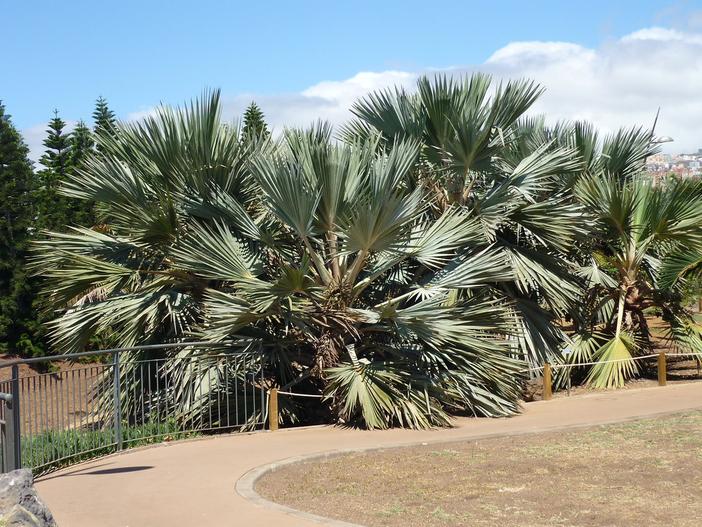Mexican Blue Palm
(Brahea armata)
Mexican Blue Palm (Brahea armata)
/
/

Jesús Cabrera
CC BY 2.0
Image By:
Jesús Cabrera
Recorded By:
Copyright:
CC BY 2.0
Copyright Notice:
Photo by: Jesús Cabrera | License Type: CC BY 2.0 | License URL: https://creativecommons.org/licenses/by/2.0/ | Uploader: jccsvq | Publisher: Flickr






























Estimated Native Range
Summary
Brahea armata, commonly known as Mexican Blue Palm, is an evergreen palm native to desert oases in Baja California and Sonora in Northwestern Mexico. It can reach a height of 15 meters (49 ft) and is characterized by a stout, columnar trunk and striking silvery-blue leaves that are 1–2 meters (3 ft 3 in – 6 ft 7 in) wide with 1-meter (3 ft 3 in) long petioles. The leaves form a dense crown and, when older, hang around the trunk creating a skirt, which is often removed in cultivation for a tidier appearance. The inflorescences are dramatic, extending 5 meters (16 ft) beyond the crown, with small, inconspicuous flowers that bloom in February and March. The fruit is brown, 18–24 millimeters (0.71–0.94 in) in length, with an ovoid to globose shape.
The Mexican Blue Palm is valued for its distinctive blue foliage and sculptural form, making it a popular choice for xeriscaping and as a focal point in gardens. It has received the Royal Horticultural Society’s Award of Garden Merit, indicating its excellence for garden use in the UK. This palm is highly drought-tolerant, requiring only occasional deep watering. It is adaptable to various light conditions, thriving in both partial shade and full sun, and is cold-hardy to −10 °C (14 °F). It is best suited to well-draining soils and can tolerate a range of soil types. While generally pest-free, it can occasionally suffer from potassium deficiency, which is treatable with appropriate fertilization.CC BY-SA 4.0
The Mexican Blue Palm is valued for its distinctive blue foliage and sculptural form, making it a popular choice for xeriscaping and as a focal point in gardens. It has received the Royal Horticultural Society’s Award of Garden Merit, indicating its excellence for garden use in the UK. This palm is highly drought-tolerant, requiring only occasional deep watering. It is adaptable to various light conditions, thriving in both partial shade and full sun, and is cold-hardy to −10 °C (14 °F). It is best suited to well-draining soils and can tolerate a range of soil types. While generally pest-free, it can occasionally suffer from potassium deficiency, which is treatable with appropriate fertilization.CC BY-SA 4.0
Plant Description
- Plant Type: Tree
- Height: 30-49 feet
- Width: 30-35 feet
- Growth Rate: Slow
- Flower Color: N/A
- Flowering Season: Spring
- Leaf Retention: Evergreen
Growth Requirements
- Sun: Full Sun
- Water: Low
- Drainage: Slow, Medium, Fast
Common Uses
Drought Tolerant, Low Maintenance, Potted Plant, Showy Flowers
Natural Habitat
Native to desert oases in Baja California and Sonora in Northwestern Mexico
Other Names
Common Names: Blue Fan Palm, Blue Hesper Palm, Gray Goddess Palm, Hesperidenpalme, Blåpalm
Scientific Names: , Brahea armata, Brahea elegans, Brahea clara, Erythea armata, Erythea clara, Erythea elegans, Brahea roezlii, Brahea armata var. microcarpa, Brahea glauca
GBIF Accepted Name: Brahea armata S.Watson